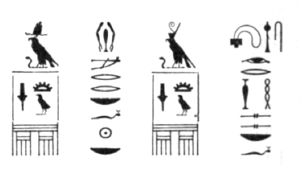شپسسکارع
| شپسسکارع | |||||||||||||||||||||||||||||||||||||||||||||||||||||||||||||||||||||||||||||||||||
|---|---|---|---|---|---|---|---|---|---|---|---|---|---|---|---|---|---|---|---|---|---|---|---|---|---|---|---|---|---|---|---|---|---|---|---|---|---|---|---|---|---|---|---|---|---|---|---|---|---|---|---|---|---|---|---|---|---|---|---|---|---|---|---|---|---|---|---|---|---|---|---|---|---|---|---|---|---|---|---|---|---|---|---|
| Sisires | |||||||||||||||||||||||||||||||||||||||||||||||||||||||||||||||||||||||||||||||||||
 Drawing by the Egyptologist Georges Émile Jules Daressy of a bronze cylinder seal of Shepseskare bearing his نامهای شاهانه در مصر باستان "Sekhemkhaw".[۱] | |||||||||||||||||||||||||||||||||||||||||||||||||||||||||||||||||||||||||||||||||||
| فرعون | |||||||||||||||||||||||||||||||||||||||||||||||||||||||||||||||||||||||||||||||||||
| فرمانروایی | Duration uncertain: likely for less than a year[۲][۳][۴][۵] or seven years[۶][۷][۸][۹] in the mid 25th century BC.[الف] (دودمان پنجم مصر) | ||||||||||||||||||||||||||||||||||||||||||||||||||||||||||||||||||||||||||||||||||
| پیشین | uncertain, نفرفرع (most likely) or نفریرکارع کاکای | ||||||||||||||||||||||||||||||||||||||||||||||||||||||||||||||||||||||||||||||||||
| جانشین | uncertain, نیوسررع (most likely) or نفرفرع | ||||||||||||||||||||||||||||||||||||||||||||||||||||||||||||||||||||||||||||||||||
| |||||||||||||||||||||||||||||||||||||||||||||||||||||||||||||||||||||||||||||||||||
شپسسکارع، که در یونانی سیسیریس نامیده میشود، فرعونی از دودمان پنجم مصر است که میان سالهای ۲۴۵۵ تا ۲۴۴۸ پیش از میلاد فرمانروایی میکرد.[۱۵] نام او به معنای «روان رع بالامرتبه است»، میباشد.[۱۶]
اطلاعات بسیار کمی از این پادشاه در دست است و او را میتوان یکی از کمشناخته شدهترین فرمانروایان این دودمان دانست. مصرشناسانی همچون میروسلاو ورنر بر این باورند که او تنها چند ماه فرمانروایی کرد. دلیل این گروه نشانههایی از هرمی مربوط به دودمان پنجم در ابو صیر است که نه تنها نیمهکاره رها شد که زیربنای آن نیز کامل نشده بوده. آثاری بر جای مانده با نام و نشان این فرعون نیز بسیار کم شمار هستند.[۱۷]
با آنکه ناتمام ماندن هرم واقع در ابو صیر نشان از آن دارد که سازنده آن دوران فرمانروایی بسیار کوتاهی داشته، هر دو فهرست تورین و مانتو زمان ۷ سال را برای شپسسکارع ذکر میکنند.
منابع[ویرایش]
- ↑ Daressy 1915, p. 94.
- ↑ Verner 2001, p. 400.
- ↑ Baker 2008, pp. 427–428.
- ↑ ۴٫۰ ۴٫۱ Hornung 2012, p. 491.
- ↑ Grimal 1988, p. 92.
- ↑ ۶٫۰ ۶٫۱ Shaw 2000, p. 480.
- ↑ ۷٫۰ ۷٫۱ Rice 1999, p. 190.
- ↑ ۸٫۰ ۸٫۱ von Beckerath 1999, p. 283.
- ↑ Hayes 1978, p. 58.
- ↑ Hawass & Senussi 2008, p. 10.
- ↑ Clayton 1994, p. 60.
- ↑ Strudwick 2005, p. xxx.
- ↑ Lloyd 2010, p. xxxiv.
- ↑ Arnold 1999.
- ↑ Shaw, Ian (۲۰۰۰). «The Oxford history of ancient Egypt». Oxford: Oxford University Press. ص. ۴۸۰. شابک ۰-۱۹-۲۸۰۴۵۸-۸.
- ↑ Dodson A., Hilton D. (۲۰۰۴)، The Complete Royal Families of Ancient Egypt، Thames & Hudson، ص. ۶۱، شابک ۰۵۰۰۰۵۱۲۸۳
- ↑ Miroslav Verner (۲۰۰۱)، Archaeological Remarks on the 4th and 5th Dynasty Chronology، Orientální (۶۹)، ص. ۳۹۳
پیوند به بیرون[ویرایش]
خطای یادکرد: خطای یادکرد: برچسب <ref> برای گروهی به نام «persian-alpha» وجود دارد، اما برچسب <references group="persian-alpha"/> متناظر پیدا نشد. ().

